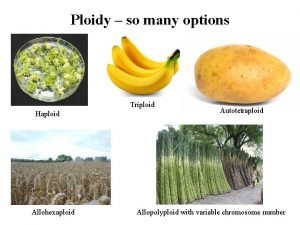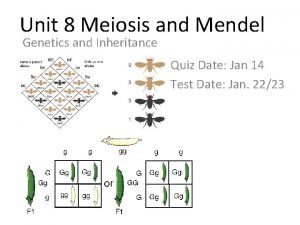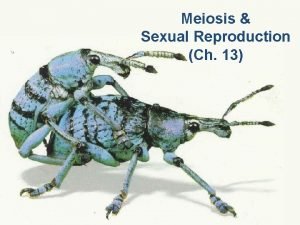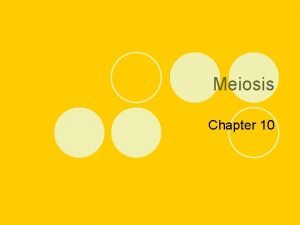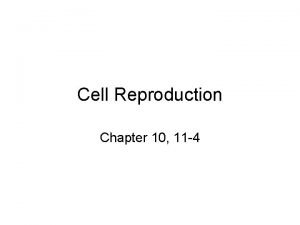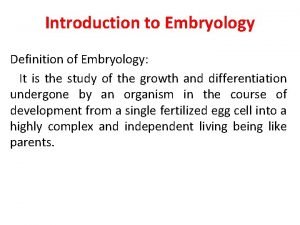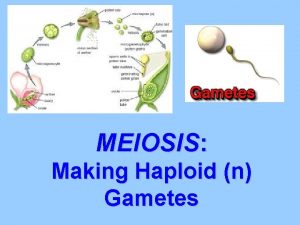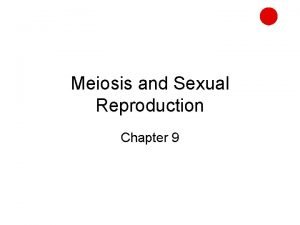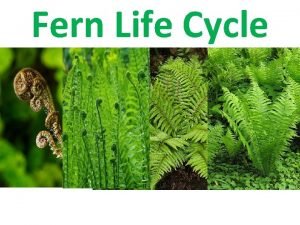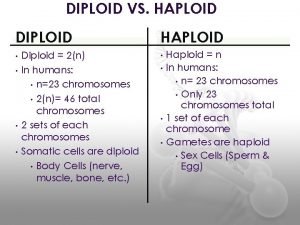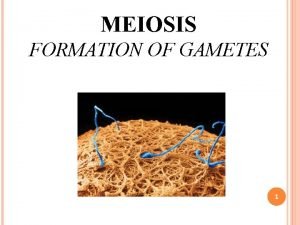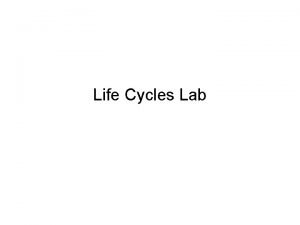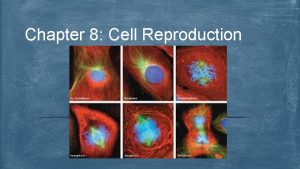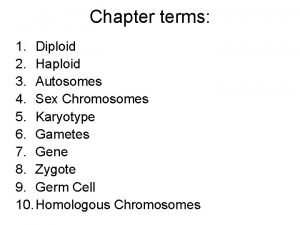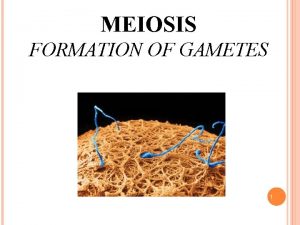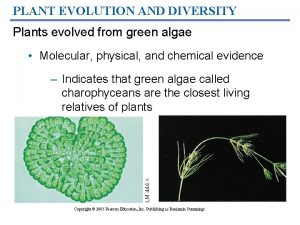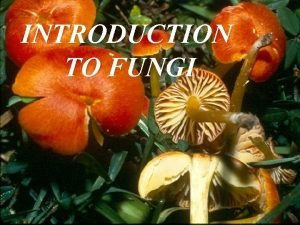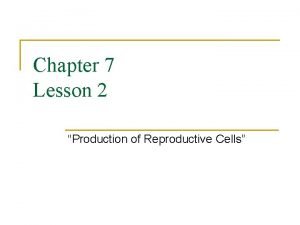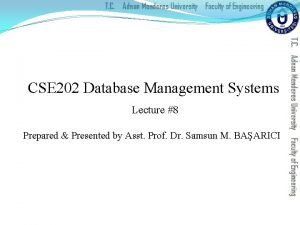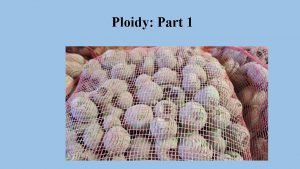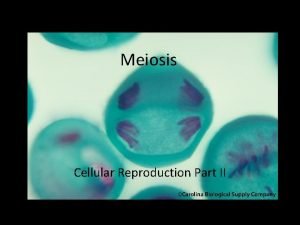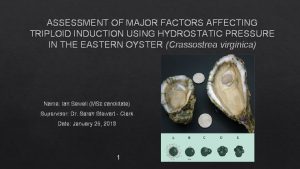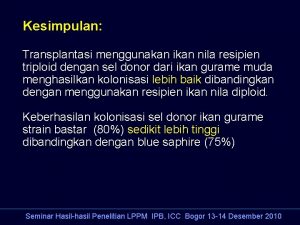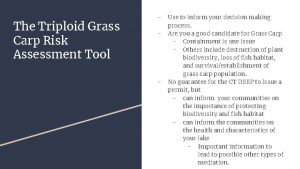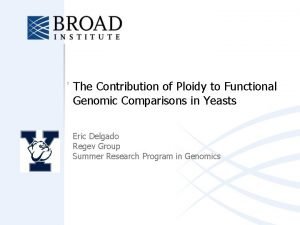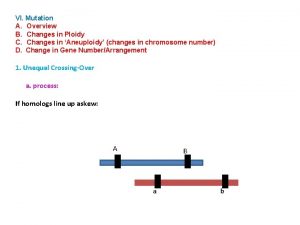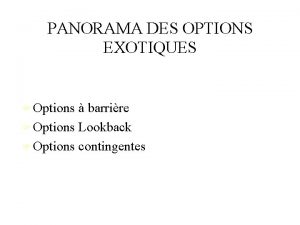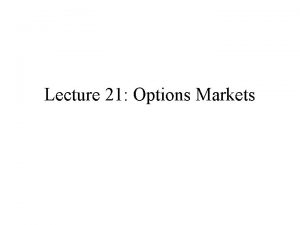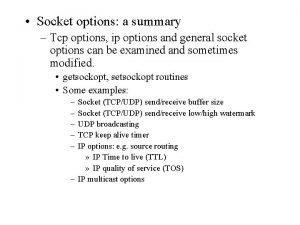Ploidy so many options Triploid Haploid Allohexaploid Autotetraploid







































- Slides: 39

Ploidy – so many options Triploid Haploid Allohexaploid Autotetraploid Allopolyploid with variable chromosome number

Impacts of Ploidy Changes • Polyploidy in cultivated and domesticated plants is widespread and of evolutionary and economic importance

Polyploidy – Pros and Cons • Advantages • Vigor effects – heterotic boost from divergent parental genomes • Redundancy – masking of recessive alleles • Buffering capacity – differential gene expression (? ) • Changes in cell structure & shape – doubling genome content may increase cell volume • Sterility (assuming that’s a goal)

Polyploidy – Pros and Cons • Possible Disadvantages • Changes in cell structure & shape – doubling genome content increases cell volume: brittle wood in timber species • Sterility – if fertility is the goal: continued problems in cell division – mitosis and meiosis

Alternation of Generations The sporophytic generation may be diploid (2 n = 2 x) or polyploid (2 n = _x) 1 pair homologous chromosomes 0 sets of homoeologous chromosomes AA A A VAVA 2 n = 2 x = 14 30, 000 genes 2 pairs of homologous chromosomes 3 pairs of homologous chromosomes 2 sets of homoeologous 3 sets of homoeologous chromosomes AABBDD AABB A A B B D D VAVAVBVBVDVD 2 n = 4 x = 28 60, 000 genes 2 n = 6 x = 42 90, 000 genes

Euploidy • An organism with an exact multiple of a basic chromosome number (x) § Can be diploid (2 x), triploid (3 x), tetraploid (4 x) …. . • Barley in the sporophytic generation is 2 n = 14 § n = 7 in the gametophtyic generation § The base number (x) = 7 = n for a diploid • Potato in the sporophytic generation is 2 n = 48 § n = 24 in the gametophytic generation but x = 12 2 n=2 x=14 2 n=4 x=48

Aneuploidy (the exception) • Not euploid – more or less chromosomes than a multiple of the basic number • Monosomic – loss of a chromosome, (2 n-1) • Trisomic – addition of a chromosome, (2 n+1) • Of value in genetic studies, particularly in polyploids

Polyploidy More than two basic sets of chromosomes • Autopolyploidy – multiple copies of each chromosome in the basic number • Allopolyploidy – two or more copies of ancestral genomes

Polyploid Formation • Genome duplication • Failure of spindle fibers in meiosis or mitosis • Must lead to balance in order to achieve euploidy and long-term viability • Imbalanced gametes = aneuploidy

Polyploids - Bivalent Pairing for viability • Must have bivalent pairing for fertility: polyploids behaving as diploids • If non-bivalent pairing, gametes will not all get the same number of chromosomes § Trivalent + of homologous chromosome pairing in autopolyploids = sterility § Homoeologous pairing in allopolyploids = sterility

Autopolyploids Even numbers (4 x, 6 x etc. ) can be fertile • Potato 2 n = 4 x = 48; Alfalfa 2 n = 4 x = 32 • Pairs of homologs = bivalents and normal meiosis Odd numbers (3 x, 5 x, …) = sterile or abnormal • Banana 2 n = 3 x = 33 • The complete chromosome complement cannot form into pairs and normal meiosis is disrupted

Genetics & Breeding of Autopolyploids Potentially very complex as up to 4 copies of an allele at each gene can be present • Nulliplex (aaaa) • Simplex (Aaaa) • Duplex (AAaa) • Triplex (AAAa) • Quadriplex (AAAA) Commons. Wikimedia. org

Inducing autopolyploids • Colchicine (and other chemicals) double the chromosome complement by interfering with spindle formation in cell division • If no spindle function at Anaphase, all homologs migrate to the same cell to give a tetraploid (2 n = 4 x = 28) What’s confusing about this image? • Can select for fertility = bivalent pairing

Inducing autopolyploids Induced autopolyploids are generally sterile: non-bivalent pairing leads to unbalanced gametes and consequently sterility. Application: Sterile ornamentals “My research program involves several areas of ornamental plant breeding and cultivar development. Of primary interest is the development of sterile forms of nonnative species that are of economic importance to Oregon growers to prevent escape from cultivation. Primary techniques to achieve sterility/reduced fertility include develoment of triploids using ploidy manipulation, as well as mutagenesis by exposing seeds or meristems to physical and chemical mutagens. ” R. Contreras, Dept. of Horticulture, Oregon State University

Autopolyploids – triploids Synthetic autopolyploids are generally sterile: non-bivalent pairing Of tremendous potential commercial value: sterility = seedless “This unassuming little Amur maple about to flower turns out to be a triploid germinated in 2017 that is going to flower 1 year from seed! We are very excited to begin testing fertility in hopes of identifying sterile (or nearly) Amur maples for the nursery and landscape industries!” OSU Ornamental Plant Breeding Facebook

Autopolyploids - triploids Create triploids by crossing a related tetraploid with a diploid • Seedless watermelon 2 n = 3 x = 33

Seedless Watermelons An infertile triploid created from 4 x and 2 x parents Tetraploid Inbred AAAA 2 n = 4 x = 44 x Diploid Inbred AA 2 n = 2 x =22 Triploid F 1 AAA 2 n = 3 x = 33 Grow with Fertile Diploid (2 n = 2 x = 22) to stimulate seedless fruit production

Seedless Watermelons The consumer benefits, but breeding is more difficult and hence expensive • Development of suitable tetraploids • Selection against sterility and fruit abnormalities • Reduced seed yield for seed company • Grower devotes ~ 30% field to 2 x pollinator http: //plantbreeding. coe. uga. edu/index. php? title=20. 6_Watermelon

Bananas (seedless) • Cultivated bananas derived from diploid species Musa acuminata (A) and Musa balbisiana (B) • Most edibles are triploids with genomes of AAA (dessert), AAB (plantains), and ABB (cooking) • Irregular pairing means bananas are seedless • Good for the consumer but problematic for the breeder and maintainer • Evidence of pairing between homoeologous chromosomes from A and B genomes • 90% desert bananas are cv. Cavendish

Genetic uniformity in triploid banana: Genome sequencing to the rescue? • Previous breeding efforts - mutation • Major effort resulted in sequencing a wild Musa acuminata genome (AA) • CRISPR-Cas 9? http: //banana-genome-hub. southgreen. fr/

Allopolyploids • An individual with chromosome sets from two or more different but related species • Interspecific hybridization followed by chromosome doubling • Spontaneous (natural forms) • Colchicine (synthesized forms) • Behave like diploids due to bivalent pairing • Homologs within each ancestral species pair even though homoeologous genomes may be collinear

Interspecific crosses: sterile unless there is doubling Interspecific hybrids have just one copy of each genome • AA x BB → AB • Haploid number of chromosomes from each species • Gametes get the unequal numbers of chromosomes, resulting in infertility • Spontaneous doubling – rare, but of tremendous evolutionary importance • Use colchicine (or other chemicals) to double the chromosome complement

Polyploidy in the Triticeae Sporophytic generation Gametophytic generation Ploidy Level Genome Formula 2 n = 14 n = 7 2 x (diploid) einkorn 2 n = 2 x = 14 2 n = 28 n = 14 4 x (tetraploid) durum, emmer 2 n = 4 x = 28 2 n = 42 n = 21 6 x (hexaploid) wheat, spelt 2 n =6 x = 42

The evolutionary paths of bread wheat and barley Hordeum spontaneum Wild barley 2 n = 2 x =14 AA=BB=DD 2 n=2 x=14 Hordeum vulgare Cultivated barley 2 n = 2 x =14

The Bread Wheat Genome

Wheat chromosome pairing • Ph 1 locus on 5 B affects pairing in wheat • Promotes homologous pairing • Blocks homoeologous pairing • Gene is cloned https: //www. jic. ac. uk/staff/graham-moore/Wheat_meiosis. htm

Triticale an allo-hexa/octaploid Wheat (durum (4 x) or bread (6 x)) X rye hybrid Bread Wheat AABBDD 2 n = 6 x = 42 x Infertile F 1 ABDR 2 n = 21 Fertile F 1 AABBDDRR 2 n = 8 x = 56 Rye RR 2 n = 2 x = 14

Brassicas – The Triangle of U (Woo Jang-choon = Nagahara U) https: //www. innovationfarm. co. uk/page/triangle-u

Brassicas – The Triangle of U

Haploids Single basic set of chromosomes • Maize: n=10; bread wheat: n=21; barley: n=7 • Haploid plants can be manipulated to grow • Only have the basic chromosome content (n): therefore infertile due to meiotic irregularity

Doubled Haploids Doubling the haploid chromosome content gives two exact copies • No heterozygotes – “instant inbred lines” • Sample pollen or egg cells from F 1 plants • A random sample of all the possible products of the first round of segregation from meiosis • Shortens the breeding cycle • Immortal genetic populations for research • Can make doubled haploids at any stage in the selfing process (e. g. F 1, F 2, F 3)

Doubled Haploids Doubled haploid production systems • Pollination by alien species • Anther/microspore culture • Haploid inducing genes

Alien species: Hordeum bulbosum DH production in barley Emasculate H. vulgare H. bulbosum pollen Pollinate H. vulgare with H. bulbosum Leave ~ 10 days for embryo to develop

Hordeum bulbosum DH production Rescue developing embryos Tissue culture Transplant Colchicine Harvest seed

Anther Culture Harvest donor spikes Apply stress conditions Place anthers on induction medium Sub-culturing for shoots and roots Spontaneous doubling Grow out Harvest seed

Doubled haploids & inbred line development in maize Hybrid maize (corn) is a major crop worldwide: hybrids derived from intermating inbred lines • Inbred line development key to hybrid breeding • Accelerate inbred line development means hybrid development also accelerated • In vitro production of doubled haploids • Anther or microspore culture https: //repository. cimmyt. org/xmlui/bitstream/handle/10883/1351/97066. pdf

The maize haploid inducer system https: //www. youtube. com/watch? v=V 2 j. OEu. Zjjrg

Crazy ploidy numbers “Saccharum species present high ploidy levels. S. officinarum is octoploid (2 n = 80) having x = 10 chromosomes. S. spontaneum has x = 8 chromosomes but presents great variation in chromosome numbers with five main cytotypes: 2 n = 62, 80, 96, 112 or 128. Modern sugarcane cultivars, which were derived from the hybridization between these two species, are considered allopolyploid hybrids with most exhibiting a 2 n + n constitution, representing two copies of the S. officinarum genome plus one copy of the S. spontaneum genome. ” Cheavegatti-Gianotto et al. 2011. doi: 10. 1007/s 12042 -011 -9068 -3

Crazy ploidy numbers 2 x, 4 x, 6 x, 12 x, 20 x Intermountainbiota. org
 Monoploidy
Monoploidy Why are triploid plants seedless
Why are triploid plants seedless Triploid banana
Triploid banana Genotypic ratios
Genotypic ratios Primary oocyte haploid or diploid
Primary oocyte haploid or diploid Haploid
Haploid Meiosis
Meiosis Primary oocyte haploid or diploid
Primary oocyte haploid or diploid Haploid
Haploid Haploid number
Haploid number Phases of oogenesis
Phases of oogenesis Produces diploid cells
Produces diploid cells 2n=2 meiosis
2n=2 meiosis What is a haploid cell?
What is a haploid cell? Gametes
Gametes Meiosis stages
Meiosis stages Ferns alternation of generations
Ferns alternation of generations Haploid vs diploid
Haploid vs diploid Diploid vs haploid number
Diploid vs haploid number Bit.ly/2m8prtt
Bit.ly/2m8prtt Somatic cells vs gametes
Somatic cells vs gametes Haploid
Haploid Separate picture
Separate picture Haploid and diploid numbers
Haploid and diploid numbers Homologous chromosome vs sister chromatid
Homologous chromosome vs sister chromatid Fonte
Fonte Primary oocyte haploid or diploid
Primary oocyte haploid or diploid Cell with 4 chromosomes
Cell with 4 chromosomes Are diploid cells produced in meiosis
Are diploid cells produced in meiosis Facts about miosis
Facts about miosis Marchantiophyta
Marchantiophyta Planogametic copulation in fungi
Planogametic copulation in fungi Haploid diploid unterschied
Haploid diploid unterschied Haploid cells def
Haploid cells def Many sellers and many buyers
Many sellers and many buyers Erm erd
Erm erd Many to many communication
Many to many communication Many buyers and sellers
Many buyers and sellers Unary many to many
Unary many to many Sqlbi many to many
Sqlbi many to many

